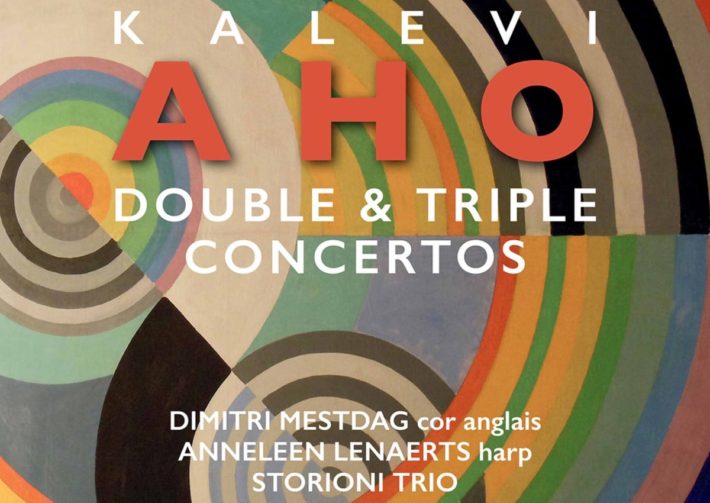BIS is one of today’s most respected labels, in part due to the consistently exceptional SACD sound of its albums, and this release is certainly no exception. But many of us admire BIS even more for its commitment to recording lesser-known living composers, especially from the Nordic and Baltic countries. The label’s ardent support of Swedish composer Kalevi Aho has resulted in over 30 recordings of his music, including 15 of the 17 symphonies, chamber works, piano and organ works. Several years ago, Aho announced his intent to compose a concerto for every instrument of the orchestra – BIS has recorded most of them, usually with the soloists who premiered the work. This newest album includes “Double Concerto for Cor Anglais and Harp” (performed by the soloists who premiered the work in 2016, Dimitri Mestdag and Anneleen Lenaerts) and “Triple Concerto,” premiered in 2019 and written for (and now recorded by) the Storioni Trio.
Aho’s compositional characteristics can be perceived as “post-modern”, but he embraces a variety of styles. While his music can occasionally embrace a high level of dissonance, it is generally tonal. A 1989 article in Finnish Music Quarterly argues that Aho embraces a “theatrical display of emotion,” like Mahler and Shostakovich. His orchestration, whether it be for small or large forces, shows a masterful understanding of the color palette each instrument affords. His music often features sharp contrasts in dynamics, tempo, and texture, and is intended, first and foremost, to provoke an emotional reaction from the listener.
Aho’s “Double Concerto” is in four movements and plays without a break. The opening minute establishes a mood of numb melancholy, suggestive of the cold, harsh Swedish winter. The English Horn’s initial entrance (1’16”) only adds to this atmosphere, its opening melodic line wandering, untethered to any harmonic foundation. At 3’35” the music becomes more urgent, the harp and wind chimes adding a brightness that is rejected by the ever more lamenting cries from the English horn. The texture becomes increasing contrapuntal, leading to an anxious climax at 7’50”. This restless energy slowly ebbs away as the music finds its way back to the opening atmosphere. The second movement, a taxing cadenza for the harp alone, is thrilling dispatched by Lenaerts. The Cor Anglais take center stage in the third movement, and Dimitri Mestdag handles the music’s considerable demands with elan. The melancholy of this music is artfully present in his plangent tone, resonant and full across the instrument’s entire range. Intonation, even in the most disjunct passages, is spot-on. The final Adagio (track 4) serves as a Coda, the dynamism of the previous movement slowly dissipating until in the composer’s own words, “the piece ends in a desolate silence.”
Related Posts
- Review: Contemporary Clarinet Concertos – Jean-Luc Votano
- Review: Beethoven and Sibelius Violin Concertos – Christian Tetzlaff
- Review: “Paris” – Hilary Hahn, Violin
The Triple Concerto is altogether happier and has significant personal meaning for the composer. In October 2017 his granddaughter was born, which led Aho to compose her a lullaby. He was also just beginning to work on this concerto, so he decided to use the lullaby as its main melodic material. The first movement is disarmingly simple, tonal and without harmonic conflict. One can imagine the composer holding his new grandchild as he sings her to sleep. The first movement’s gentleness makes the agitation of the second movement even more distressing. The soloist and orchestra struggle to establish control of the melodic material, allowing Aho to write suitably difficult music for each of the soloists. Strings and piano have cascading scales and angular motifs with difficult string crossing, played here with a muscular energy and passion. Despite the third movement’s Tranquillo marking and quiet opening, its harmonies suggest the angst of the previous movement is still present. At the five-minute mark the music becomes increasingly dissonant and rhythmically complicated, building to a terse and emotionally ambiguous climax. The final movement is more extrovert and joyful, though again in the final minute unexpected harmonic juxtapositions negate any effort to reach the innocent joy that began the first movement. Throughout the work, the Storioni Trio play with consummate mastery and full emotional commitment.
In both concertos, the Antwerp Symphony Orchestra under conductor Olari Elts provide expert and characterful accompaniments. These premiere recordings should be considered definitive – it is unlikely that other competing versions will be produced, and if there are, it is hard to imagine better playing. The BIS SACD recording is vividly detailed and warmly resonant, with exemplary balance between the soloists and orchestra. Lovers of Sibelius and Rautavaara should find Aho’s music equally thrilling – he is surely one of the finest living composers today. Long may this fruitful relationship continue

Aho – Double & Triple Concertos
Antwerp Symphony Orchestra
Olari Elts – Conductor
BIS, CD 2426
Related Albums
Read more classical music reviews or visit The Classic Review Amazon store
Follow Us and Comment:
Get our periodic classical music newsletter with our recent reviews, news and beginners guides.
We respect your privacy.









